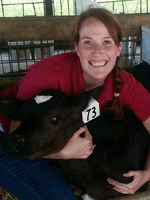
Calf Diarrhea Giving You the Runaround? – Dr. Emily Schier, Lena Veterinary Clinic
 By Dr. Emily Schier, Lena Veterinary Clinic
By Dr. Emily Schier, Lena Veterinary ClinicWhen you look out into your calf pens, do you feel like you are just running into problems? Does it feel like everything is jetting out of control? Can you just see the money hemorrhaging out of your pockets?
Well, it could be that your scouring problems are caused by the most common viruses found throughout the world: rotavirus and coronavirus.
These viruses are acquired through the ingestion or inhalation of feces-contaminated material. This usually comes from one of four places:
- Being born into a manure or straw pack that is excessively dirty
- Trying to stand for the first couple of times and nose-diving into manure or a dirty pack
- Nursing on a dirty teat or suckling the mother’s leg or any other mucky body part
- Being placed into pens or hutches that are dirty or not disinfected thoroughly
Rotavirus attacks the epithelial cells in the small intestine, which are responsible for absorbing nutrients and protecting the body from bacteria passing through to the bloodstream. This damage makes it impossible for nutrients, electrolytes, and fluids to be absorbed, which leads to dehydration, diarrhea, and metabolic acidosis. Coronavirus is similar in its attack, but can also affect the colon.
You are probably asking yourself these questions: “Is my calf scouring really a virus? Could it be bacteria or protozoa?”
The correct answer is that – depending on the examination of the calf, the type of diarrhea, and environment – it could be one or all of these!
The only way to know for sure is to take a fecal sample to your veterinarian and let them diagnose the problem. Antibiotics do not help much with these viruses. Fluid therapy is needed to correct dehydration, circulatory impairment and electrolyte/metabolic imbalances. Fluids can be administered orally, subcutaneously or intravenously. Only use oral fluids and electrolyte solutions if the calf is still nursing. If it has no suckle response, the calf needs IV fluids.
Since treating these viruses is tricky, the following tips below can help prevent these devastating diseases.
- Reduce viral exposure by calving in a clean maternity area and moving the calf to a clean area as soon as possible after birth.
- Those handling sick calves should practice strict biosecurity measures to reduce exposure to healthy neonates.
- Employees should wash their hands and disinfect their boots after handling sick calves. They should keep their clothes free of fecal material or change their clothes between sick and healthy animals.
- All equipment, bottles and nipples should be sufficiently cleaned and disinfected between calf usages.
- Vaccinate! Oral vaccination of calves with a modified live oral vaccine will produce IgA and IgM antibodies to help fight these viruses.
- Remember: The vaccination (Calf-Guard/First Defense) must be given 30 minutes before colostrum consumption or it will not have the correct absorption rate to be effective.
- Make sure that the calf gets the adequate amount of colostrum before gut closure at 24 hours. The rule of thumb is 4 quarts in the first four hours of life.
- Test colostrum with a colostrometer or Brix refractometer to make sure the quality of colostrum that you are giving is accurate.
- Calves should be kept in dry and draft-free environment.
- Calves should be moved and fed in such a way to reduce the buildup of mud and fecal material in that animal’s environment.
- Diarrheic animals should be isolated from healthy calves as they are a source for large numbers of pathogens.
- Vaccination of dams prepartum with rotaviral vaccine may help to increase colostral antibody.
| Category: |
Animal health Facility design Sanitation Starting Strong - Calf Care |

